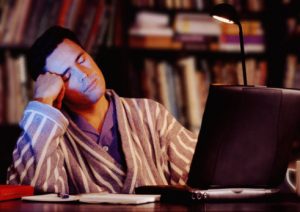 With 40 million Americans suffering from sleep disorders, research into sleep behavior is constant, and in recent years experts have been able to link parasomnia sleep disorders with sleep apnea.
With 40 million Americans suffering from sleep disorders, research into sleep behavior is constant, and in recent years experts have been able to link parasomnia sleep disorders with sleep apnea.
Parasomnia sleep disorder is a group of abnormal behaviors that can take place when a person in sleeping. Some sleep disorder parasomnias include sleep-related eating disorder, nightmares, sleep walking, sleep paralysis and sleep aggression.
Advertisement
Sleep includes two different states; rapid eye movement sleep or REM, and non-rapid eye movement or NREM. These two states alternate throughout the sleep cycle. Parasomnia can take place in any state of sleep, as well as during a sleep-wake transition. They can also be classified into two syndromes. For instance, sleep disorders of arousal tend to happen during NREM. REM parasomnias are more likely to take place during the later half of the sleep period when REM sleep is most abundant.
When a person wakes from an REM parasomnia, he or she is usually alert and has good memory of his or her dream and mental activity. People with NREM parasomnias who wake up during the course of sleep are normally confused and find it difficult to recall dreaming – they have no recollection of their behavior or mental activity in the morning. This is what we often refer to as being half awake and half asleep.
Types of parasomnia sleep disorders
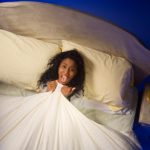 There are many different types of parasomnia, but one of the most well-known or talked about is night terrors. A person having a night terror wakes up abruptly from sleep in a terrified state. The person seems to be awake, yet is confused and usually unable to speak. Night terrors only last a few minutes, and in most cases the person just lies down afterwards and falls right back to sleep. Night terrors occur during deep sleep and are common in children between the ages of three and five. It can also occur in adults, especially if they are experiencing strong emotional tension in their lives.
There are many different types of parasomnia, but one of the most well-known or talked about is night terrors. A person having a night terror wakes up abruptly from sleep in a terrified state. The person seems to be awake, yet is confused and usually unable to speak. Night terrors only last a few minutes, and in most cases the person just lies down afterwards and falls right back to sleep. Night terrors occur during deep sleep and are common in children between the ages of three and five. It can also occur in adults, especially if they are experiencing strong emotional tension in their lives.
Although this sounds like one of those parasomnia types that can only occur in the movies, sexsomnia or sexsleep is real. This happens when people attempt to have intercourse during sleep. It can have serious repercussions. In 2014 a Swedish man was acquitted of rape after his lawyer was able to prove that he suffered from sexsomnia.
Here is a list of other types of parasomnia sleep disorders:
- Nightmares
- Sleep walking
- Confusional arousals
- Rhythmic movement disorder
- Sleep Talking
- Nocturnal leg cramps
- Sleep paralysis
- Sleep bruxism
This list of parasomnias is just the beginning; there are other sleep disorder parasomnias that are less common and those still being officially classified.
Study has found patients with obstructive sleep apnea experience “parasomnia” symptoms
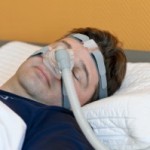 Perhaps one of the most interesting discoveries in recent years is sleep apnea parasomnia. Researchers at Loyola University Chicago Stritch School of Medicine evaluated sleep apnea patients and discovered that nearly one in 10 also experienced parasomnia.
Perhaps one of the most interesting discoveries in recent years is sleep apnea parasomnia. Researchers at Loyola University Chicago Stritch School of Medicine evaluated sleep apnea patients and discovered that nearly one in 10 also experienced parasomnia.
So how did they identify participants as parasomniacs? Simply by evaluating symptoms of people with sleep apnea during sleep tests. Close to 10 percent of their patients reported one or more parasomnia symptoms, including acting out dreams, sleep walking, eating while sleeping, hallucinating and experiencing sleep paralysis, which is the inability to move the body or limbs when either falling asleep or waking up.
Obstructive sleep apnea is when you have one or more pauses in breathing or shallow breaths while you are sleeping. When this happens, the brain wakes you up so you can resume breathing.
While many studies over the years have associated obstructive sleep apnea with a higher risk of heart attacks and stroke, the Loyola study suggests sleep apnea also increases parasomnia symptoms.
Causes and risks of parasomnias
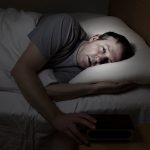 A parasomnia can happen while a person is falling asleep or at another point in the sleep cycle. If it happens when falling asleep, you can experience hallucinations that can be really disturbing. You can also experience sleep paralysis. In some cases, people have had both sleep paralysis and frightening hallucinations.
A parasomnia can happen while a person is falling asleep or at another point in the sleep cycle. If it happens when falling asleep, you can experience hallucinations that can be really disturbing. You can also experience sleep paralysis. In some cases, people have had both sleep paralysis and frightening hallucinations.
Parasomnia causes vary. For example, they can be genetic – meaning they are hereditary and run in families. For some parasomniacs the cause is related to a brain disorder. Of course, as outlined here, sleep apnea is now considered a possible cause. It is also important to point out that some medical evidence suggests certain medications could potentially trigger parasomnia symptoms.
Statistics show that parasomnias affect about 10 percent of Americans. Children are more susceptible to parasomnia because their brains are still maturing. The positive news when it comes to kids though – their parasomnia is normally not associated with serious health problems and often disappears as they mature.
Diagnosis and treatment of parasomnias
If you think you or someone in your family might be a parasomniac, it should be taken seriously, especially if you feel the sleep behaviors could be dangerous to you or to others.
Parasomnia treatment can be attained through a sleep medicine physician, who will help you determine what is causing the parasomnia. He or she will look at the possibility of other sleep disorders, medical conditions, medications, possible substance abuse and possible psychological elements. An examination at a sleep lab can also help a doctor pinpoint the cause.
Sleep studies chart your brain activity, heartbeat and breathing when you sleep. Video allows for behavior monitoring. Doctors can see how you move during sleep and whether you get up and do anything unusual.
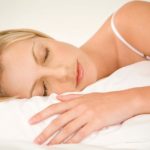 In terms of actual parsomnia treatment, a physician may recommend behavioral therapy, medication or a combination of the two. Lifestyle changes are also suggested in many cases. For example, if someone sleep walks they can add locks or alarms to windows and doors. They can try sleeping on the ground and clear the room of items that could cause them to trip and fall.
In terms of actual parsomnia treatment, a physician may recommend behavioral therapy, medication or a combination of the two. Lifestyle changes are also suggested in many cases. For example, if someone sleep walks they can add locks or alarms to windows and doors. They can try sleeping on the ground and clear the room of items that could cause them to trip and fall.
People who suffer from sleep apnea parasomnia could be treated with what is known as a CPAP, a system to help open airways for better breathing.
Whether someone suffers from parasomnia or sleep apnea parasomnia they can minimize their symptoms by trying to get a full night’s sleep every night, keeping a regular sleep schedule, using medications as directed and making adjustments in work schedules if they are shift workers. Avoiding alcohol, caffeine and recreational drugs is also highly recommended.
Related Reading:
Insomnia, parasomnia and OSA increase risk of cancer
Insomnia, parasomnia and obstructive sleep apnea (OSA) have been found to increase the risk of cancer. It has long been known that insomnia, parasomnia and sleep apnea are associated with many other ailments… Continue reading…
Advertisement
Fibromyalgia and sleep disorders: Link between sleep apnea, insomnia and restless legs syndrome
Fibromyalgia is linked with sleep disorders such as sleep apnea, insomnia and restless legs syndrome. Fibromyalgia is a condition where a person experiences all-over pain and stiffness, from the joints to the muscles. Continue reading…
Sources:
http://www.statisticbrain.com/sleeping-disorder-statistics
http://www.ncbi.nlm.nih.gov/pmc/articles
https://sleepfoundation.org/ask-the-expert/sleep-and-parasomnias
http://www.ibtimes.com.au/swedish-man-acquitted-rape-trial-due-sexsomnia
http://www.eurekalert.org/pub_releases/2009-06/luhs
http://www.webmd.com/sleep-disorders/guide/parasomnias
http://www.sleepeducation.org/essentials-in-sleep/parasomnias/symptoms
http://www.sleepeducation.org/essentials-in-sleep/parasomnias/diagnosis-treatment
